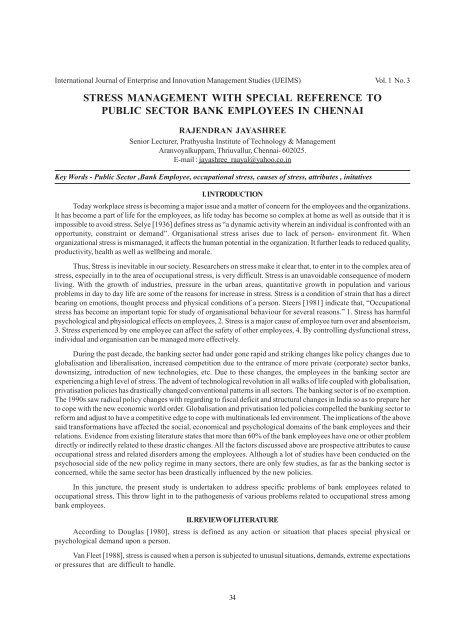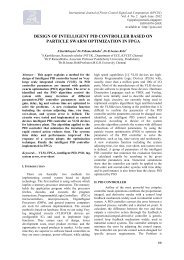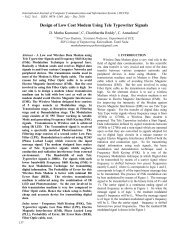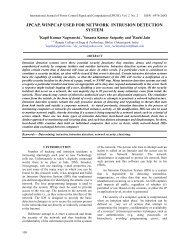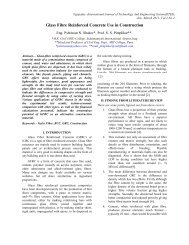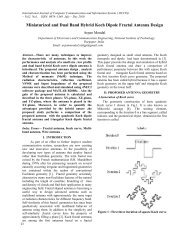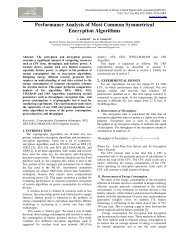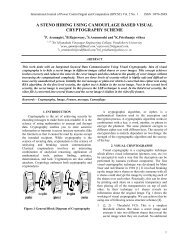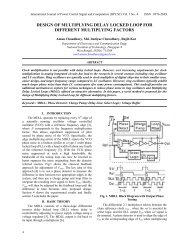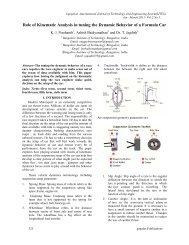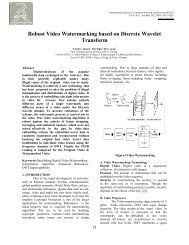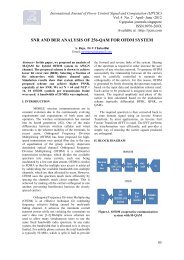stress management with special reference to public ... - Ijcns.com
stress management with special reference to public ... - Ijcns.com
stress management with special reference to public ... - Ijcns.com
You also want an ePaper? Increase the reach of your titles
YUMPU automatically turns print PDFs into web optimized ePapers that Google loves.
International Journal of Enterprise and Innovation Management Studies (IJEIMS) Vol. 1 No. 3<br />
STRESS MANAGEMENT WITH SPECIAL REFERENCE TO<br />
PUBLIC SECTOR BANK EMPLOYEES IN CHENNAI<br />
RAJENDRAN JAYASHREE<br />
Senior Lecturer, Prathyusha Institute of Technology & Management<br />
Aranvoyalkuppam, Thriuvallur, Chennai- 602025.<br />
E-mail : jayashree_raayal@yahoo.co.in<br />
Key Words - Public Sec<strong>to</strong>r ,Bank Employee, occupational <strong>stress</strong>, causes of <strong>stress</strong>, attributes , initatives<br />
I. INTRODUCTION<br />
Today workplace <strong>stress</strong> is be<strong>com</strong>ing a major issue and a matter of concern for the employees and the organizations.<br />
It has be<strong>com</strong>e a part of life for the employees, as life <strong>to</strong>day has be<strong>com</strong>e so <strong>com</strong>plex at home as well as outside that it is<br />
impossible <strong>to</strong> avoid <strong>stress</strong>. Selye [1936] defines <strong>stress</strong> as “a dynamic activity wherein an individual is confronted <strong>with</strong> an<br />
opportunity, constraint or demand”. Organisational <strong>stress</strong> arises due <strong>to</strong> lack of person- environment fit. When<br />
organizational <strong>stress</strong> is mismanaged, it affects the human potential in the organization. It further leads <strong>to</strong> reduced quality,<br />
productivity, health as well as wellbeing and morale.<br />
Thus, Stress is inevitable in our society. Researchers on <strong>stress</strong> make it clear that, <strong>to</strong> enter in <strong>to</strong> the <strong>com</strong>plex area of<br />
<strong>stress</strong>, e<strong>special</strong>ly in <strong>to</strong> the area of occupational <strong>stress</strong>, is very difficult. Stress is an unavoidable consequence of modern<br />
living. With the growth of industries, pressure in the urban areas, quantitative growth in population and various<br />
problems in day <strong>to</strong> day life are some of the reasons for increase in <strong>stress</strong>. Stress is a condition of strain that has a direct<br />
bearing on emotions, thought process and physical conditions of a person. Steers [1981] indicate that, “Occupational<br />
<strong>stress</strong> has be<strong>com</strong>e an important <strong>to</strong>pic for study of organisational behaviour for several reasons.” 1. Stress has harmful<br />
psychological and physiological effects on employees, 2. Stress is a major cause of employee turn over and absenteeism,<br />
3. Stress experienced by one employee can affect the safety of other employees, 4. By controlling dysfunctional <strong>stress</strong>,<br />
individual and organisation can be managed more effectively.<br />
During the past decade, the banking sec<strong>to</strong>r had under gone rapid and striking changes like policy changes due <strong>to</strong><br />
globalisation and liberalisation, increased <strong>com</strong>petition due <strong>to</strong> the entrance of more private (corporate) sec<strong>to</strong>r banks,<br />
downsizing, introduction of new technologies, etc. Due <strong>to</strong> these changes, the employees in the banking sec<strong>to</strong>r are<br />
experiencing a high level of <strong>stress</strong>. The advent of technological revolution in all walks of life coupled <strong>with</strong> globalisation,<br />
privatisation policies has drastically changed conventional patterns in all sec<strong>to</strong>rs. The banking sec<strong>to</strong>r is of no exemption.<br />
The 1990s saw radical policy changes <strong>with</strong> regarding <strong>to</strong> fiscal deficit and structural changes in India so as <strong>to</strong> prepare her<br />
<strong>to</strong> cope <strong>with</strong> the new economic world order. Globalisation and privatisation led policies <strong>com</strong>pelled the banking sec<strong>to</strong>r <strong>to</strong><br />
reform and adjust <strong>to</strong> have a <strong>com</strong>petitive edge <strong>to</strong> cope <strong>with</strong> multinationals led environment. The implications of the above<br />
said transformations have affected the social, economical and psychological domains of the bank employees and their<br />
relations. Evidence from existing literature states that more than 60% of the bank employees have one or other problem<br />
directly or indirectly related <strong>to</strong> these drastic changes. All the fac<strong>to</strong>rs discussed above are prospective attributes <strong>to</strong> cause<br />
occupational <strong>stress</strong> and related disorders among the employees. Although a lot of studies have been conducted on the<br />
psychosocial side of the new policy regime in many sec<strong>to</strong>rs, there are only few studies, as far as the banking sec<strong>to</strong>r is<br />
concerned, while the same sec<strong>to</strong>r has been drastically influenced by the new policies.<br />
In this juncture, the present study is undertaken <strong>to</strong> address specific problems of bank employees related <strong>to</strong><br />
occupational <strong>stress</strong>. This throw light in <strong>to</strong> the pathogenesis of various problems related <strong>to</strong> occupational <strong>stress</strong> among<br />
bank employees.<br />
II. REVIEW OF LITERATURE<br />
According <strong>to</strong> Douglas [1980], <strong>stress</strong> is defined as any action or situation that places <strong>special</strong> physical or<br />
psychological demand upon a person.<br />
Van Fleet [1988], <strong>stress</strong> is caused when a person is subjected <strong>to</strong> unusual situations, demands, extreme expectations<br />
or pressures that are difficult <strong>to</strong> handle.<br />
34
International Journal of Enterprise and Innovation Management Studies (IJEIMS) Vol. 1 No. 3<br />
Cobb (1975) has the opinion that, “The responsibility load creates severe <strong>stress</strong> among workers and managers.”<br />
If the individual manager cannot cope <strong>with</strong> the increased responsibilities it may lead <strong>to</strong> several physical and psychological<br />
disorders among them. Brook (1973) reported that qualitative changes in the job create adjustmental problem among<br />
employees. The interpersonal relationships <strong>with</strong>in the department and between the departments create qualitative<br />
difficulties <strong>with</strong>in the organisation <strong>to</strong> a great extent.<br />
Miles and Perreault (1976) identify four different types of role conflict: 1. Intra-sender role conflict 2. Inter sender<br />
role conflict. 3. Person- role conflict; 4. Role over load. The use of role concepts suggests that job related <strong>stress</strong> is<br />
associated <strong>with</strong> individual, interpersonal, and structural variables (Katz and Kahn, 1978; Whetten, 1978). The presence<br />
of supportive peer groups and supportive relationships <strong>with</strong> super visors are negatively correlated <strong>with</strong> R.C. (Caplan et<br />
al., 1964).<br />
There is evidence that role incumbents <strong>with</strong> high levels of role ambiguity also respond <strong>to</strong> their situation <strong>with</strong><br />
anxiety, depression, physical symp<strong>to</strong>ms, a sense of futility or lower self esteem, lower levels of job involvement and<br />
organisational <strong>com</strong>mitment, and perceptions of lower performance on the part of the organisation, of supervisors, and of<br />
themselves (Brief and Aldag, 1976; Greene, 1972).<br />
Ivancevich and Matteson (1950) indicate, “Lack of group cohesiveness may explain various physiological and<br />
behavioural out<strong>com</strong>es in an employ desiring such sticks <strong>to</strong>gether.” Workplace interpersonal conflicts and negative<br />
interpersonal relations are prevalent sources of <strong>stress</strong> and are existed <strong>with</strong> negative mood depression, and symp<strong>to</strong>ms of<br />
ill health.<br />
Occupational <strong>stress</strong> is an increasingly important occupational health problem and a significant cause of economic<br />
loss. Occupational <strong>stress</strong> may produce both overt psychological and physiologic disabilities. However it may also<br />
cause subtle manifestation of morbidity that can affect personal well-being and productivity (Quick, Murphy, Hurrel and<br />
Orman, 1992). A job <strong>stress</strong>ed individual is likely <strong>to</strong> have greater job dissatisfaction, increased absenteeism, increased<br />
frequency of drinking and smoking, increase in negative psychological symp<strong>to</strong>ms and reduced aspirations and self<br />
esteem (Jick and Payne, 1980). The use of role concepts suggests that occupational <strong>stress</strong> is associated <strong>with</strong> individual,<br />
interpersonal and structural variables (Kutz and Kahn, 1978; Whetten, 1978).<br />
Studies on burnout found that, it is related <strong>to</strong> exhaustion and work over load fac<strong>to</strong>rs in various organisations<br />
(Green and Walkey, 1988; Chermiss, 1980; Freudenberger, 1977, 1980). Stress on the job is costly for employers, reflected<br />
in lower productivity, reduced motivation and job skills, and increased and accidents.<br />
The purpose present study is an attempt <strong>to</strong> investigate and <strong>to</strong> <strong>com</strong>pare the level of <strong>stress</strong> experienced by the<br />
employees of the Nationalised banks in Chennai. The study aims <strong>to</strong> ascertain the level of <strong>stress</strong> and <strong>to</strong> analyse the<br />
various attributes which influence organizational <strong>stress</strong> on bank employees.<br />
III. SCOPE OF THE STUDY<br />
United States National Institute of Occupational Safety and Health has defined workplace <strong>stress</strong> as “The harmful<br />
physical and emotional responses that occur when the requirements of the job do not match the capabilities, resources,<br />
or needs of the worker. Job <strong>stress</strong> can lead <strong>to</strong> poor health and even injury.” Workers who are <strong>stress</strong>ed are also more likely<br />
<strong>to</strong> be unhealthy, poorly motivated, less productive and less safe at work. Their organizations are less likely <strong>to</strong> be successful<br />
in a <strong>com</strong>petitive market. Stress can be brought about by pressures at home and at work. Employers cannot usually protect<br />
workers from <strong>stress</strong> arising outside of work, but they can protect them from <strong>stress</strong> that arises through work. Stress at<br />
work can be a real problem <strong>to</strong> the organization as well as for its workers. Good <strong>management</strong> and good work organization are<br />
the best forms of <strong>stress</strong> prevention. This study is helpful in assessing the extent of <strong>stress</strong> experienced by the employees.<br />
IV. OBJECTIVE OF THE STUDY<br />
‣ The primary aim for the study is <strong>to</strong> analysis the job <strong>stress</strong> among the <strong>public</strong> sec<strong>to</strong>r bank employees in Chennai<br />
V. SECONDARY OBJECTIVE<br />
‣ To examine what is the effect of <strong>stress</strong> on work fac<strong>to</strong>rs (e.g., morale, job satisfaction, task effort, organizational<br />
<strong>com</strong>mitment, etc) when people are under high <strong>stress</strong>.<br />
‣ To assess the extent of experienced di<strong>stress</strong> and consequent quality of life among the employees<br />
‣ To identify different methods and techniques <strong>to</strong> reduce job-related <strong>stress</strong>.<br />
35
International Journal of Enterprise and Innovation Management Studies (IJEIMS) Vol. 1 No. 3<br />
VI. METHODOLOGY OF THE STUDY<br />
A] POPULATION<br />
The population selected for this particular study is employees from <strong>public</strong> sec<strong>to</strong>r units in Chennai. Public sec<strong>to</strong>r<br />
<strong>com</strong>prise of Union Bank of India, Vijaya Bank and the State Bank of India. Questionnaire were distributed and collected<br />
personally by the researcher.<br />
B] RESEARCH DESIGN<br />
The study is explorative as well as descriptive in nature.<br />
C] SAMPLE DESIGN<br />
The particulars of sample design,<br />
1. TYPE OF UNIVERSE : Finite.<br />
2. SAMPLING UNIT : Chennai<br />
3. SOURCE LIST : Public Sec<strong>to</strong>r Employees<br />
4. SIZE OF SAMPLE : 100<br />
5. PARAMETER OF INTEREST: In estimating the number of persons being <strong>stress</strong>ed in their jobs.<br />
D] TOOL OF DATA COLLECTION<br />
A pilot testing was conducted initially by administering the questionnaire on around 10 numbers of respondents.<br />
The information was collected from the bank employees at all the levels. Interviews were conducted <strong>with</strong> the employees<br />
for gathering information on their perception about their organization and the problems which they face both directly<br />
and indirectly in the discharge of their responsibilities. The respondents were questioned on the issues affecting the<br />
<strong>stress</strong> levels of the employees, impact of family pressures on their work, expectations from their roles, up <strong>to</strong> what extent<br />
they are satisfied and possible suggestions for over<strong>com</strong>ing the adversities of <strong>stress</strong> by evaluating the individual<br />
initiatives and organizational initiatives.<br />
E] SOURCES OF DATA<br />
The study will consist of both primary and secondary data. The primary data was collected by direct interview<br />
through questionnaire. The secondary data was collected from research <strong>public</strong>ations, standard journal and periodicals<br />
including the government organizations and from respective records about the job related occurrence.<br />
F] RESEARCH INSTRUMENT-QUESTIONNAIRE METHOD<br />
The instrument will be administered in the workplaces of each group. Data will be collected from the employees.<br />
Data will be collected using a structured questionnaire, which will be distributed in the workplace <strong>to</strong> employees and in<br />
Chennai city.<br />
G] ANALYSIS OF DATA<br />
The data will be analyzed <strong>to</strong> determine any differences between the <strong>stress</strong> levels of employees and their impact on<br />
reducing <strong>stress</strong>.<br />
VII. RESULTS AND DISCUSSIONS<br />
This paper also includes an analysis of data collected by respresenting it in tabular form along <strong>with</strong> interpretations.<br />
The information collected were analysed for arriving at proper conclusion on the <strong>to</strong>pic.<br />
TABLE NO : 1<br />
PERCENTAGE OF RESPONDENTS WHO FELT THAT THEY WERE STRESSED<br />
Category<br />
% of Respondents<br />
Stressed 97<br />
Not Stressed 03<br />
36
International Journal of Enterprise and Innovation Management Studies (IJEIMS) Vol. 1 No. 3<br />
From the table 1, it is indicated that majority of the respondents working in <strong>public</strong> sec<strong>to</strong>r banks were <strong>stress</strong>ed,<br />
whereas only few respondents felt that they were not <strong>stress</strong>ed.<br />
Causes of Stress<br />
TABLENO : 2<br />
CAUSES OF STRESS<br />
% of Respondents<br />
Work overload 21<br />
Lack of Acceptability 04<br />
Time Management 08<br />
Lack of Support 06<br />
Feeling of Inequality 08<br />
Job Difficulty 14<br />
Inadequacy of Role Authority 03<br />
Impatient cus<strong>to</strong>mer 19<br />
Stress due <strong>to</strong> technological problem 17<br />
From Table 2, it is inferred that major causes of <strong>stress</strong> among the bank employees are excess of work load [21%] and<br />
lack of cooperation among the impatient cus<strong>to</strong>mer [17%].<br />
Hence it was found that employees felt that they were facing severe work pressure, as they were expected <strong>to</strong><br />
handle multiple roles and responsibilities. Time <strong>stress</strong> is created by a real or imaginary deadlines; encounter <strong>stress</strong> is<br />
created by contact <strong>with</strong> other people [both pleasant and unpleasant], and in this study, the employees suffer from <strong>stress</strong><br />
because of lack of support from the <strong>management</strong> and colleagues.<br />
TABLE NO : 3<br />
VARIOUS ATTRIBUTES OF STRESS<br />
Various Attributes of Stress<br />
Communication Gap 14<br />
Lack of skills 05<br />
Work Life Imbalance 46<br />
Work Environment 14<br />
Unmatched Expectations 08<br />
Economic Status 07<br />
Resource Inadequacy 06<br />
% of Respondents<br />
The above table depicts the various attributes related <strong>to</strong> <strong>stress</strong>; work life imbalance is one of the major attribute<br />
which contribute <strong>to</strong> <strong>stress</strong> for an employee. This can be regarded as a fac<strong>to</strong>r building up <strong>stress</strong> because a lot of<br />
employees <strong>com</strong>plained that they were unable <strong>to</strong> balance both the personal and professional fronts successfully. Extra<br />
work pressures and demands from work environment at times led <strong>to</strong> neglect of personal front.<br />
37
International Journal of Enterprise and Innovation Management Studies (IJEIMS) Vol. 1 No. 3<br />
TABLE NO : 4<br />
INITIATIVES FOR HANDLING THE STRESS LEVELS OF THE BANK EMPLOYEES<br />
Initiatives of Stress<br />
% of Respondents<br />
Good Ambience 16<br />
Recognition 18<br />
Continuous Training 13<br />
Effective Communication 15<br />
Programme on <strong>stress</strong> <strong>management</strong> 15<br />
Meditation 23<br />
From the above table, it is interpreted that Meditation form an integral part of the science of Yoga, has a direct,<br />
positive impact on the mind giving it the strength and power <strong>to</strong> resist <strong>stress</strong>. Moreover, around 18 percent of the<br />
respondents expected that they required recognition as acknowledging people’s value is e<strong>special</strong>ly important in times of<br />
<strong>stress</strong>. Based on the analysis; the initiatives taken by the banks <strong>to</strong> reduce <strong>stress</strong> are by providing good ambience,<br />
continuous training, proper <strong>com</strong>munication and conducting effective <strong>stress</strong> <strong>management</strong> programmes.<br />
<br />
<br />
<br />
<br />
VIII. FINDINGS OF THE STUDY<br />
About 97 % of the respondents belived that they face high level of <strong>stress</strong>, which may be due <strong>to</strong> both professional<br />
and personal reasons<br />
The respondent were overburdened <strong>with</strong> work load in their work place<br />
Work life imbalance is one of the major attribute which contribute <strong>to</strong> <strong>stress</strong> for an employee.<br />
The researcher identified few initiatives for effectively handling <strong>stress</strong>. Meditation was found <strong>to</strong> be the integral<br />
part of life <strong>to</strong> reduce <strong>stress</strong>.<br />
IX. IMPLICATION OF STRESS<br />
1. Physical problems and health problems like heart diseases, ulcers, arthritis, increased frequency of drinking and<br />
smoking, cardiovascular, gastrointestinal, endocrine and other <strong>stress</strong> related disorders<br />
2. Psychological and behavioural problems: psychological problems like change of moods, inferiority <strong>com</strong>plex,<br />
widespread resentment, reduced aspirations and self esteem, reduced motivation and job skills,<br />
3. Organisational: job dissatisfaction, behavioural problems, production turn over, increased absenteeism, increased<br />
accidents, lower productivity,<br />
X. SUGGESTION AND RECOMMENDATIONS<br />
1. Organize a Stress Management Program that focuses on different leave categories of employees at all hierarchical<br />
level.<br />
2. Take adequate steps <strong>to</strong> redesign jobs, which are taxing <strong>to</strong> employees’ abilities and capacities.<br />
3. Adequate role clarification <strong>to</strong> be made whenever necessary <strong>to</strong> eliminate role ambiguity.<br />
4. Introduce more job oriented training programs, which improve employees skill and their confidence <strong>to</strong> work effectively.<br />
5. Encourage open channel of <strong>com</strong>munication <strong>to</strong> deal work related <strong>stress</strong>.<br />
6. Undertake <strong>stress</strong> audit at all levels in the organization <strong>to</strong> identify <strong>stress</strong> area improving conditions of job and<br />
alleviating job <strong>stress</strong>.<br />
7. Introduce ‘Pranayam’ (Brain Stilling and control of Vital Force) as a holistic managerial strategy <strong>to</strong> deal <strong>with</strong><br />
occupational strategy.<br />
38
International Journal of Enterprise and Innovation Management Studies (IJEIMS) Vol. 1 No. 3<br />
8. Provide counseling on work related and personnel problems and support from a team of welfare health and counseling<br />
staff.<br />
9. Attractive system of reward and recognition of good work.<br />
XI. CONCLUSION<br />
The problem of <strong>stress</strong> is inevitable and unavoidable in the banking sec<strong>to</strong>r. A majority of the employees face severe<br />
<strong>stress</strong>- related aliments and a lot of psychological problems. Hence, the <strong>management</strong> must take several initiatives in<br />
helping their employees <strong>to</strong> over<strong>com</strong>e its disastrous effect.<br />
Since <strong>stress</strong> in banking sec<strong>to</strong>r is mostly due <strong>to</strong> excess of work pressure and work life imbalance the organization<br />
should support and encourage <strong>to</strong> take up roles that help them <strong>to</strong> balance work and family.<br />
Theproductivity of the work force is the most decisive fac<strong>to</strong>r as far as the success of an organisation is concerned.<br />
The productivity in turn is dependant on the psychosocial well being of the employees. In an age of highly dynamic and<br />
<strong>com</strong>petitive world, man is exposed <strong>to</strong> all kinds of <strong>stress</strong>ors that can affect him on all realms of life. The growing<br />
importance of interventional strategies is felt more at organisational level. This particular research was intended <strong>to</strong> study<br />
the impact of occupational <strong>stress</strong> on Nationalized Bank employees. Although certain limitations were met <strong>with</strong> the study,<br />
every effort has been made <strong>to</strong> make it much <strong>com</strong>prehensive.<br />
REFERENCES<br />
1. Albrecht K [1979], Stress and the Manager, Englewood Cliffs; Prentice Hall, Nj.<br />
2. Jyothi Budhraja , “ Causes of <strong>stress</strong> among insurance employees: An empirical study; The ICFAI journal of Marketing<br />
research, Vol.VII, No.10, 2008 pp7-14.<br />
3. Gender Difference in <strong>stress</strong> among bank officers of Private and Public Sec<strong>to</strong>r; The ICFAI journal of Marketing<br />
research, Vol.VIII, No.2, 2009 ,pp63-69.<br />
4. Selye, H. (1974). “Stress <strong>with</strong>out Di<strong>stress</strong>.” Harper and Row Publications, U.S.A.<br />
5. Bajpai, B.L. (1992). “Stress <strong>management</strong>.” Financial Express, Bombay, June.<br />
6. Vijayashree. L. & Dr. Katyayani .J, Gender perspective <strong>to</strong>wards <strong>stress</strong> fac<strong>to</strong>rs: Retail employees, Bangalore; Sona<br />
Journal of Marketing Research, Vol 1 , Issue 1, January 2009, pp 57-65.<br />
39


